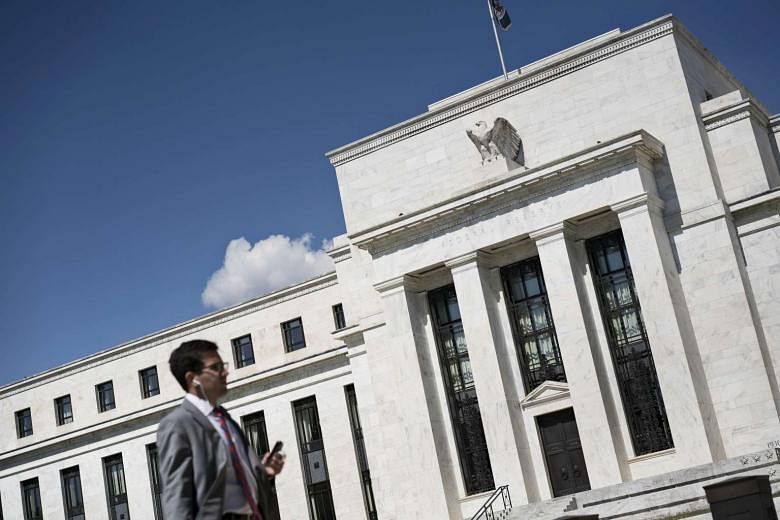WASHINGTON (BLOOMBERG) - US Federal Reserve officials pivoted toward a December interest-rate increase, betting that further job gains will lead to higher inflation over time and allow them to close an unprecedented era of near-zero borrowing costs.
The Federal Open Market Committee dropped a reference to global risks and referred to its "next meeting" on Dec 15-16 as it discussed liftoff timing in a statement released Wednesday (Oct 28) in Washington, preparing investors for the first rate rise since 2006.
"The case for a December liftoff continues to build," said Ward McCarthy, chief financial economist at Jefferies LLC in New York. "Even with the weaker data of late, it is hard to make the case that the economy is still in an emergency" that requires rates near zero.
Yields on two-year Treasuries jumped to around 0.70 per cent after the news, from 0.63 per cent at 12:30 pm in New York, as the Fed's hawkish tone caught some investors off-guard. Part of the reason for the surprise was that only last month officials seemed concerned that slowing growth abroad could delay progress toward attaining higher inflation, which Fed-watchers viewed as a warning that liftoff might get pushed into 2016.
The Fed has held its benchmark overnight federal funds rate in a zero to 0.25 per cent range since December 2008 as it sought to heal the harm done by the deepest recession since the Great Depression.
Wednesday's FOMC decision also reasserts policy maker's forecast that even moderate growth will continue to push unemployment lower and lead to higher inflation over time. The Fed has missed its 2 per cent inflation goal for more than three years.
"This statement tells you they believe that," said Michael Gapen, chief US economist for Barclays Plc. "Yellen is choosing the forecast-based decision on raising rates" rather than waiting to see signs that inflation is starting to move, he said.
Fed officials disagree on the risks around that strategy. Chicago Fed President Charles Evans, a voting member of the FOMC this year, and Fed Governor Lael Brainard have both argued that the risk of raising interest rates too early outweighs the risk of waiting, given the limits of adding further stimulus with the policy rate so close to zero.
"The main source of contention now is about the inflation outlook," said Andrew Levin, a former Yellen adviser who is now an economist at Dartmouth College in New Hampshire. "The crux of the issue for December is whether they are reasonably confident that inflation will be heading back to target."
Also, the Fed's own record of forecasting inflation hasn't been that great. In September last year, officials projected the personal consumption expenditures price index, minus food and energy, to be 1.6 per cent to 1.9 per cent in the fourth quarter of 2015.
Prices will probably undershoot Fed officials' estimate, according to economists surveyed by Bloomberg, who forecast a core inflation rate of 1.4 per cent in the final three months of 2015 compared to the same quarter last year.
Prices minus food and energy, or so-called core inflation, has shown few signs of moving. It has ranged between 1.25 per cent and 1.35 per cent in the eight reported months of this year.
Aggressive Fed policy action helped drive unemployment to 5.1 per cent in September from 6.1 per cent in August last year. The September jobless rate is only slightly above the 4.9 per cent rate officials estimate would be consistent with full employment.
Fed officials in September forecast unemployment to average 4.8 per cent in the fourth quarter of the next three years. That slight undershoot of their full employment estimate is what, in their view, helps lift inflation to their 2 percent goal by 2018.
One reason for different views within the committee is that the US economy is on two tracks, which the Fed acknowledged in its statement Wednesday.
It said consumer spending and business investment have been increasing at "solid rates," while housing continues to improve. Meanwhile, export-oriented manufacturers have been pummeled by the US dollar's strength against major trading partners.
Richmond Fed President Jeffrey Lacker dissented on Wednesday, as he did in September, in favor of a quarter percentage point rate rise. He is looking at strong consumption data and that's telling him that interest rates are too low.
"The longer we keep real interest rates so far out of alignment with consumption growth, the more risk we run," he told Bloomberg News in an interview earlier this month.
Aneta Markowska, chief US economist at Societe Generale in New York, said waiting for inflation to arrive also has its own deflationary risks, as imbalances build in the economy that then trigger a financial crises, which can in turn stunt growth and lead back to disinflation.
"The risk of staying at zero for an extended period of time is you cause imbalances," she said. "You then risk a fairly disorderly unwinding of those imbalances and then you are back in deflation."

